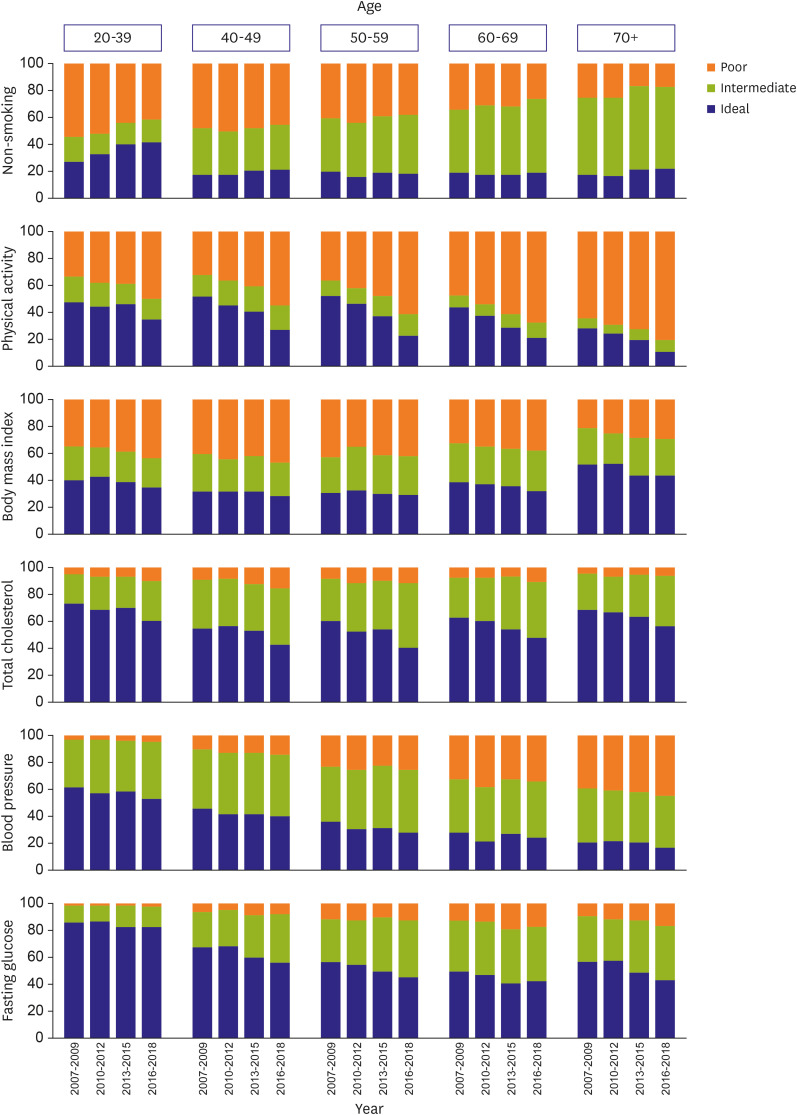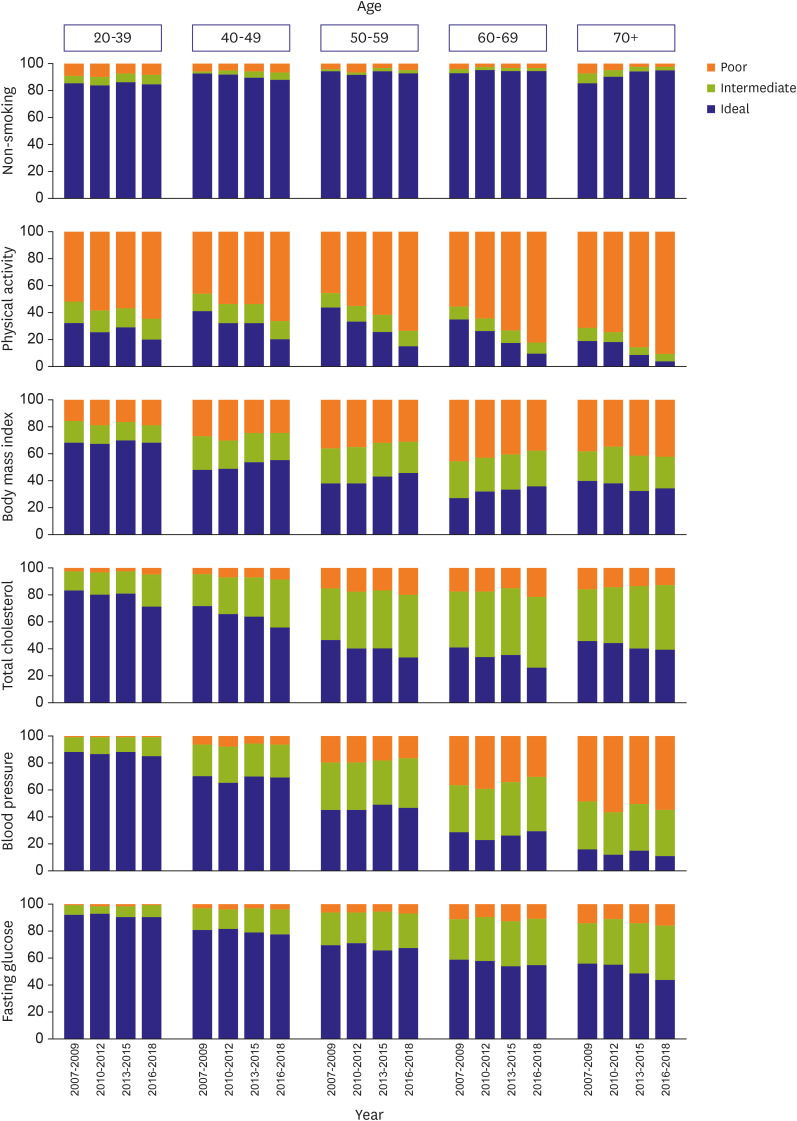Korean Circ J.
2021 Nov;51(11):922-935. 10.4070/kcj.2021.0211.
Sex- and Age-Specific Trends in Cardiovascular Health in Korea, 2007–2018
- Affiliations
-
- 1Program in Medical and Population Genetics and the Cardiovascular Disease Initiative, Broad Institute of MIT and Harvard, Cambridge, MA, USA
- 2Cardiovascular Research Center, Massachusetts General Hospital, Boston, MA, USA
- 3Department of Preventive Medicine, Yonsei University College of Medicine, Seoul, Korea
- 4Integrative Research Center for Cerebrovascular and Cardiovascular Diseases, Seoul, Korea
- 5Department of Internal Medicine, Yonsei University College of Medicine, Seoul, Korea
- KMID: 2522110
- DOI: http://doi.org/10.4070/kcj.2021.0211
Abstract
- Background and Objectives
We illustrated sex- and age-specific temporal trends in cardiovascular health among Korean adults.
Methods
From the Korean National Health and Nutrition Examination Survey 2007–2018, we included 61,408 participants aged 20 years or older. The ideal levels of 6 components of cardiovascular health metrics were defined as never-smoking, ≥75 min/week of vigorous or ≥150 min/week of moderate-to-vigorous physical activity, body mass index (BMI) <23 kg/ m2 , total cholesterol <200 mg/dL, blood pressure (BP) <120/80 mmHg, and fasting glucose <100 mg/dL. Temporal trends in the number of ideal cardiovascular health components and distribution of each component were assessed by sex and age.
Results
The average number of ideal cardiovascular health components decreased from 3.37 in 2007–2009 to 2.86 in 2016–2018. Never smoking increased from 56.0% to 59.2%, largely contributed by young men. Ideal physical activity halved (41.4–21.3%); such decline was more pronounced in women and with older age. Ideal BMI decreased from 44.3% to 42.2%, more apparently in young and elderly men. In contrast, ideal BMI increased in middle-aged and elderly women. Ideal cholesterol decreased from 65.5% to 50.3%, profoundly in young adults and relatively greater in men. Ideal BP declined from 55.1% to 46.9%, more evidently in men. However, ideal BP discernibly increased in middle-aged women. Ideal glucose decreased from 74.6% to 66.0%, comparatively greater and earlier in men.
Conclusions
The proportion of Korean adults with ideal cardiovascular health decreased between 2007 and 2018, but the course of responsible factors differed across sex and age groups.
Figure
Cited by 3 articles
-
Solvitur Ambulando: Importance of Exercise in Middle-Age for Cardiovascular Health
Hae-Young Lee
Korean Circ J. 2021;51(11):936-938. doi: 10.4070/kcj.2021.0308.A ‘Gender Paradox’ of Female as a Stroke Risk in Atrial Fibrillation: Do Women Live Longer Than Men?
Joo Hee Jeong, Jong-Il Choi
Korean Circ J. 2022;52(8):604-605. doi: 10.4070/kcj.2022.0175.Korean Society of Heart Failure Guidelines for the Management of Heart Failure: Definition and Diagnosis
Jae Yeong Cho, Dong-Hyuk Cho, Jong-Chan Youn, Darae Kim, Sang Min Park, Mi-Hyang Jung, Junho Hyun, Jimi Choi, Hyun-Jai Cho, Seong-Mi Park, Jin-Oh Choi, Wook-Jin Chung, Byung-Su Yoo, Seok-Min Kang,
Korean Circ J. 2023;53(4):195-216. doi: 10.4070/kcj.2023.0046.
Reference
-
1. Roth GA, Mensah GA, Johnson CO, et al. Global burden of cardiovascular diseases and risk factors, 1990–2019 Update from the GBD 2019 Study. J Am Coll Cardiol. 2020; 76:2982–3021. PMID: 33309175.2. Baek J, Lee H, Lee HH, Heo JE, Cho SMJ, Kim HC. Thirty-six year trends in mortality from diseases of circulatory system in Korea. Korean Circ J. 2021; 51:320–332. PMID: 33821581.
Article3. Park HK, Lee Y, Kang BW, et al. Progress on sodium reduction in South Korea. BMJ Glob Health. 2020; 5:e002028.
Article4. Park JW, Kwon SM, Kim NH. Analysis of studies on physical activity program for adults and elderly in Korea. Journal of Digital Convergence. 2013; 11:651–659.
Article5. Oh SW. The current status and challenges of national smoking cessation support program in Korea. Korean J Fam Med. 2019; 40:351–352. PMID: 31779062.
Article6. Lee J, Kim HS, Kim DJ. Recent technology-driven advancements in cardiovascular disease prevention. Cardiovasc Prev Pharmacother. 2019; 1:43–49.7. Lee HH, Cho SMJ, Lee H, et al. Korea heart disease fact sheet 2020: analysis of nationwide data. Korean Circ J. 2021; 51:495–503. PMID: 34085422.
Article8. Kim HC, Cho SMJ, Lee H, et al. Korea hypertension fact sheet 2020: analysis of nationwide population-based data. Clin Hypertens. 2021; 27:8. PMID: 33715619.
Article9. Cho SMJ, Lee H, Lee HH, et al. Dyslipidemia fact sheets in Korea 2020: an analysis of nationwide population-based data. J Lipid Atheroscler. 2021; 10:202–209. PMID: 34095012.
Article10. Jung CH, Son JW, Kang S, et al. Diabetes fact sheets in Korea, 2020: an appraisal of current status. Diabetes Metab J. 2021; 45:1–10. PMID: 33434426.
Article11. Lloyd-Jones DM, Hong Y, Labarthe D, et al. Defining and setting national goals for cardiovascular health promotion and disease reduction: the American Heart Association's strategic Impact Goal through 2020 and beyond. Circulation. 2010; 121:586–613. PMID: 20089546.12. Lee DH, Nam JY, Kwon S, et al. Lifestyle risk score and mortality in Korean adults: a population-based cohort study. Sci Rep. 2020; 10:10260. PMID: 32581249.
Article13. Jousilahti P, Vartiainen E, Tuomilehto J, Puska P. Sex, age, cardiovascular risk factors, and coronary heart disease: a prospective follow-up study of 14 786 middle-aged men and women in Finland. Circulation. 1999; 99:1165–1172. PMID: 10069784.14. Kweon S, Kim Y, Jang MJ, et al. Data resource profile: the Korea National Health and Nutrition Examination Survey (KNHANES). Int J Epidemiol. 2014; 43:69–77. PMID: 24585853.
Article15. Yook SM, Park S, Moon HK, Kim K, Shim JE, Hwang JY. Development of Korean Healthy Eating Index for adults using the Korea National Health and Nutrition Examination Survey data. J Nutr Health. 2015; 48:419.
Article16. Jee Y, Jung KJ, Lee S, Back JH, Jee SH, Cho SI. Smoking and atherosclerotic cardiovascular disease risk in young men: the Korean Life Course Health Study. BMJ Open. 2019; 9:e024453.
Article17. Min C, Yoo DM, Wee JH, Lee HJ, Byun SH, Choi HG. Mortality and cause of death in physical activity and insufficient physical activity participants: a longitudinal follow-up study using a national health screening cohort. BMC Public Health. 2020; 20:1469. PMID: 32993602.
Article18. Cho Y, Cudhea F, Park JH, et al. Estimating change in cardiovascular disease and diabetes burdens due to dietary and metabolic factors in Korea 1998–2011: a comparative risk assessment analysis. BMJ Open. 2016; 6:e013283.
Article19. Jee SH, Pastor-Barriuso R, Appel LJ, Suh I, Miller ER 3rd, Guallar E. Body mass index and incident ischemic heart disease in South Korean men and women. Am J Epidemiol. 2005; 162:42–48. PMID: 15961585.
Article20. Kwon D, Yi JJ, Ohrr H, Yi SW. Total cholesterol and mortality from ischemic heart disease and overall cardiovascular disease in Korean adults. Medicine (Baltimore). 2019; 98:e17013. PMID: 31490384.
Article21. Lee H, Cho SMJ, Park JH, Park S, Kim HC. 2017 ACC/AHA blood pressure classification and cardiovascular disease in 15 million adults of age 20–94 years. J Clin Med. 2019; 8:1832.
Article22. Kim HK, Kim CH, Kim EH, et al. Impaired fasting glucose and risk of cardiovascular disease in Korean men and women: the Korean Heart Study. Diabetes Care. 2013; 36:328–335. PMID: 23002083.23. Kim S, Chang Y, Cho J, et al. Life's simple 7 cardiovascular health metrics and progression of coronary artery calcium in a low-risk population. Arterioscler Thromb Vasc Biol. 2019; 39:826–833. PMID: 30700133.
Article24. Corlin L, Short MI, Vasan RS, Xanthakis V. Association of the duration of ideal cardiovascular health through adulthood with cardiometabolic outcomes and mortality in the Framingham Offspring Study. JAMA Cardiol. 2020; 5:549–556. PMID: 32159731.
Article25. Lee H, Yano Y, Cho SMJ, et al. Associations of ideal cardiovascular health and its change during young adulthood with premature cardiovascular events: a nationwide cohort study. Circulation. 2021; 144:90–92. PMID: 34120447.
Article26. Mosca L, Barrett-Connor E, Wenger NK. Sex/gender differences in cardiovascular disease prevention: what a difference a decade makes. Circulation. 2011; 124:2145–2154. PMID: 22064958.27. Lind L, Sundström J, Ärnlöv J, Lampa E. Impact of aging on the strength of cardiovascular risk factors: a longitudinal study over 40 years. J Am Heart Assoc. 2018; 7:e007061. PMID: 29306895.
Article28. Arnett DK, Blumenthal RS, Albert MA, et al. 2019 ACC/AHA guideline on the primary prevention of cardiovascular disease: a report of the American College of Cardiology/American Heart Association Task Force on Clinical Practice Guidelines. Circulation. 2019; 140:e596–e646. PMID: 30879355.
Article
- Full Text Links
- Actions
-
Cited
- CITED
-
- Close
- Share
- Similar articles
-
- Erratum: Correction of Funding Statement in the Article “Sex- and Age-Specific Trends in Cardiovascular Health in Korea, 2007–2018”
- Trends of Diabetes and Prediabetes Prevalence among Korean Adolescents From 2007 to 2018
- Sex-Specific Trends in the Prevalence of Hypertension and the Number of People With Hypertension: Analysis of the Korea National Health and Nutrition Examination Survey (KNHANES) 1998–2018
- Erratum: Correction of Author’s name in the Article “Sex-Specific Trends in the Prevalence of Hypertension and the Number of People With Hypertension: Analysis of the Korea National Health and Nutrition Examination Survey (KNHANES) 1998–2018”
- Trends in dietary intake and food sources of long-chain polyunsaturated fatty acids among Korean adults between 2007 and 2018




